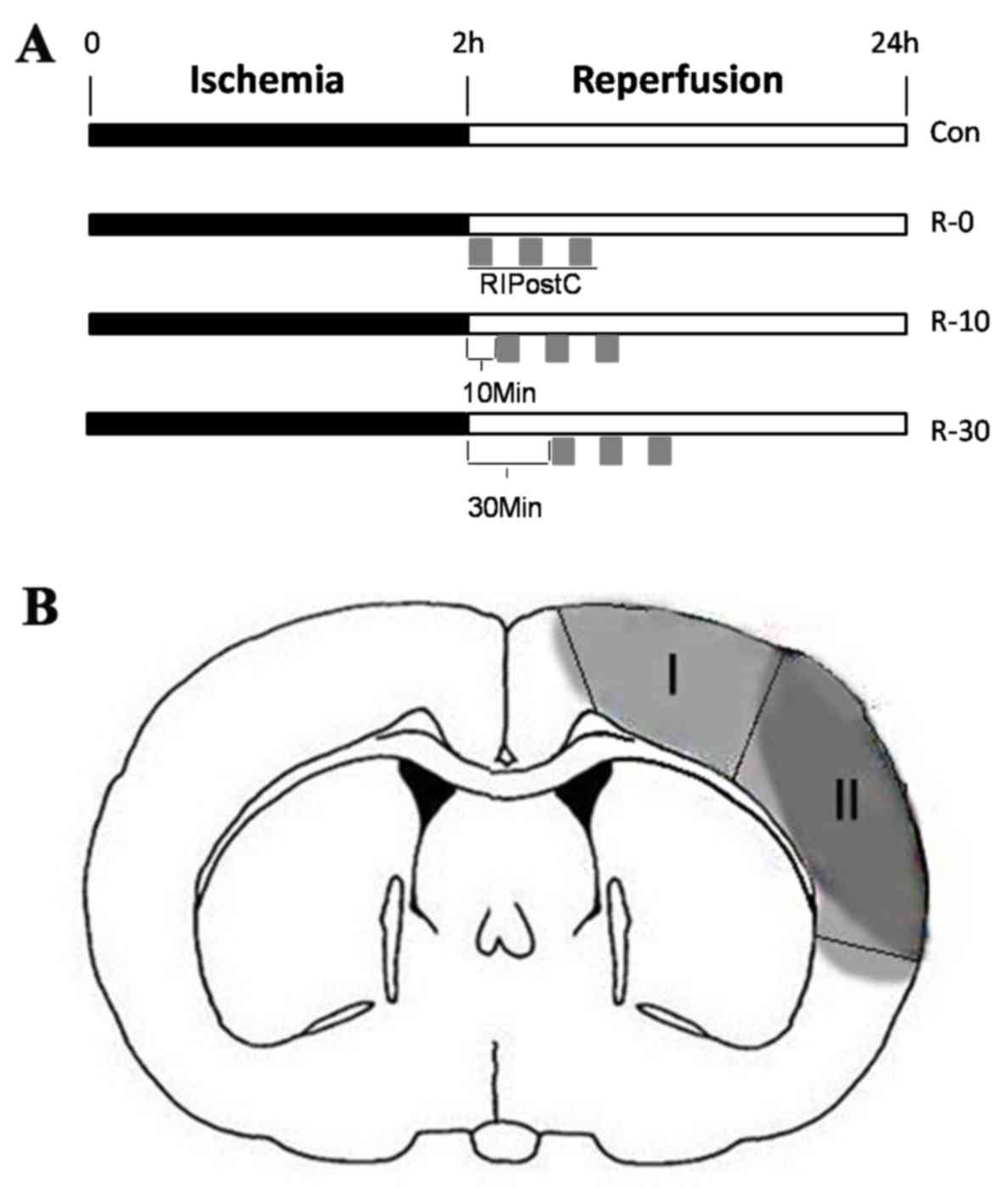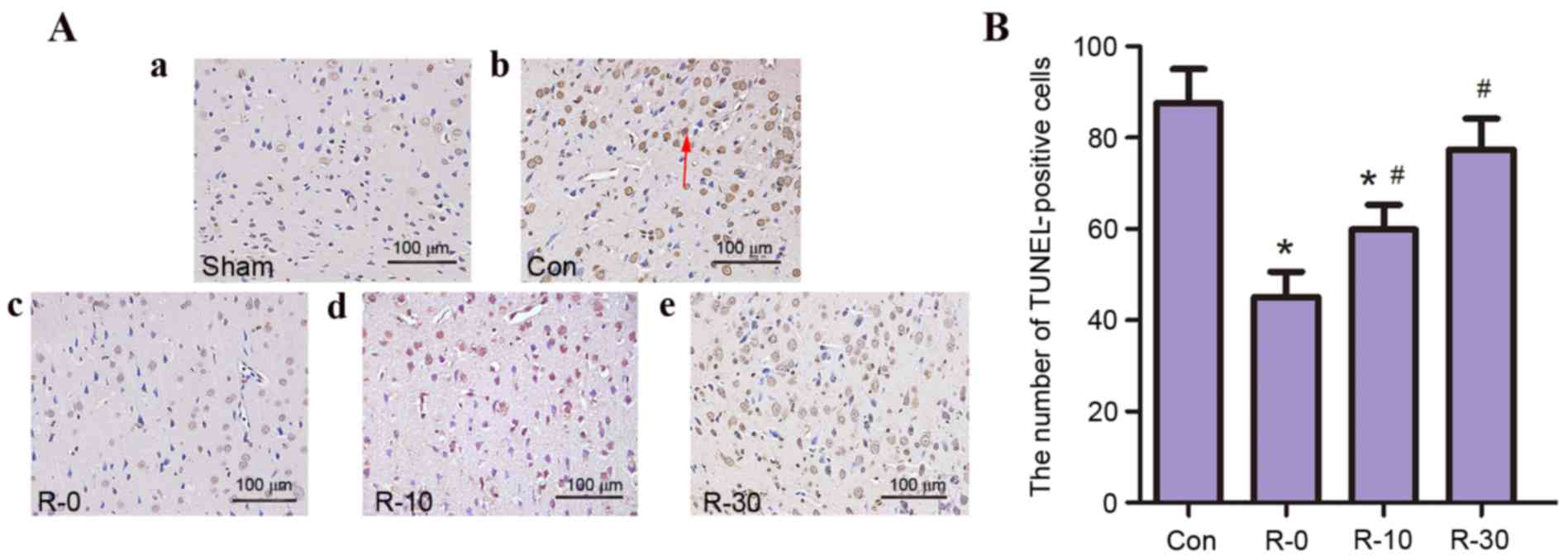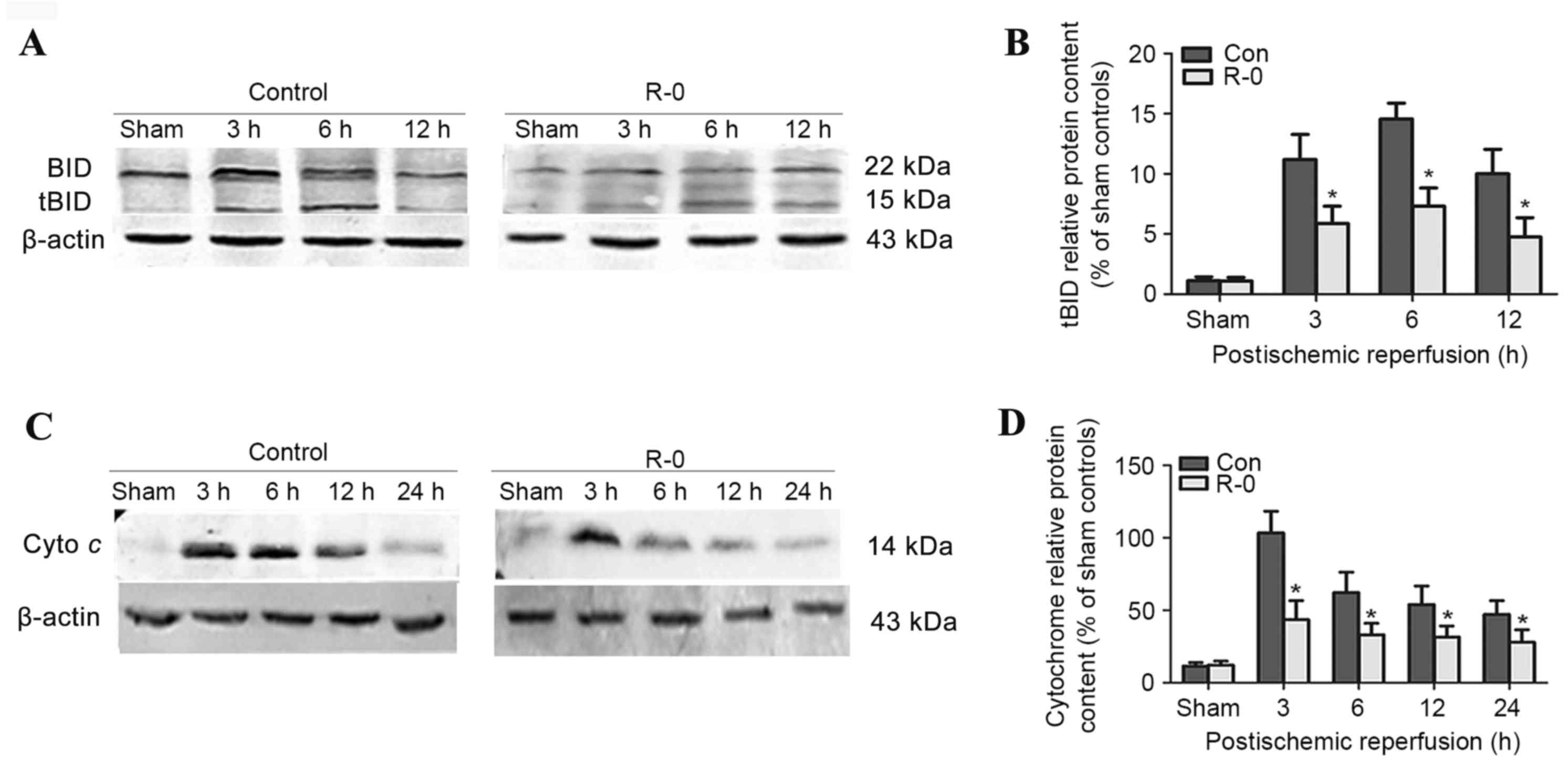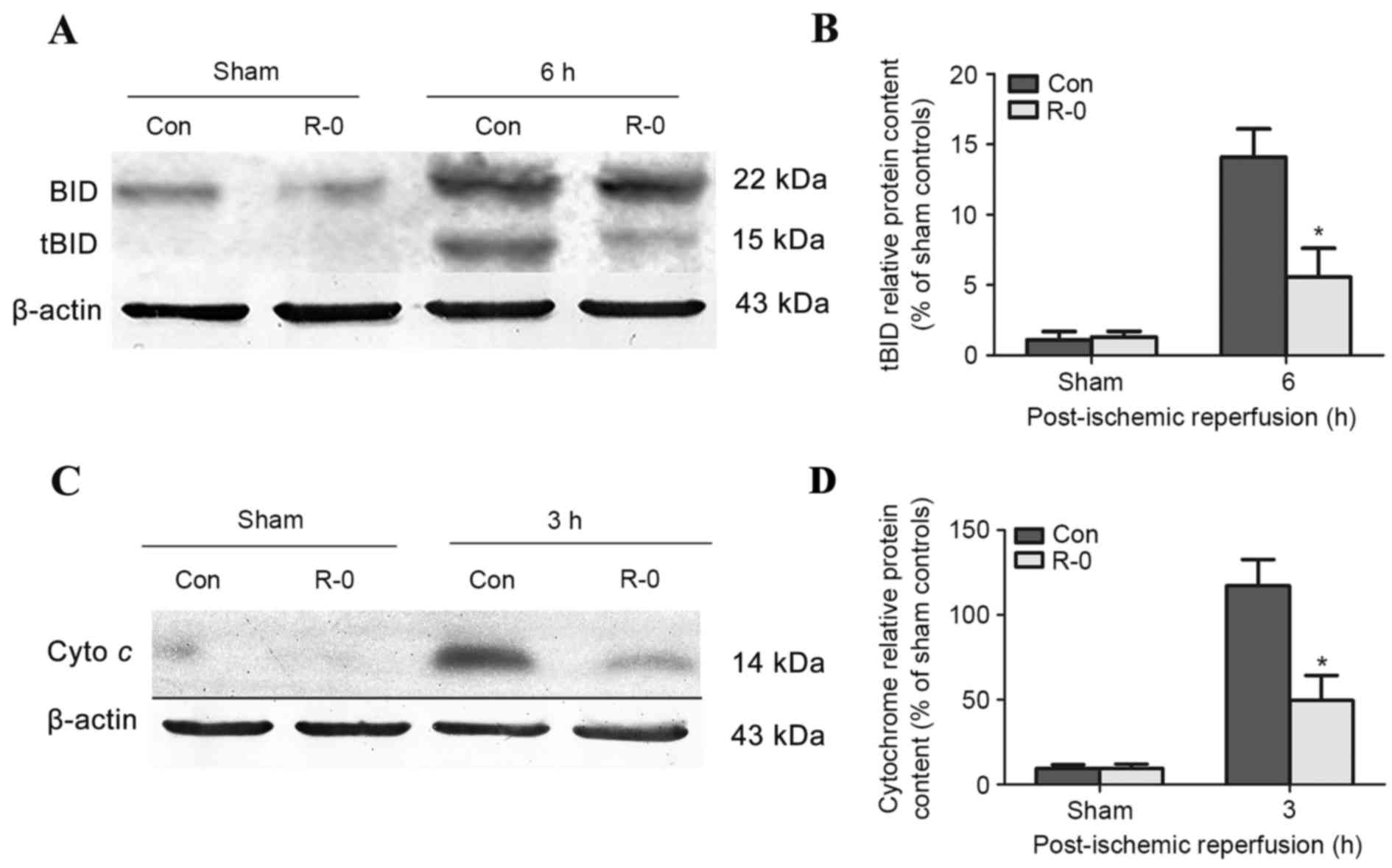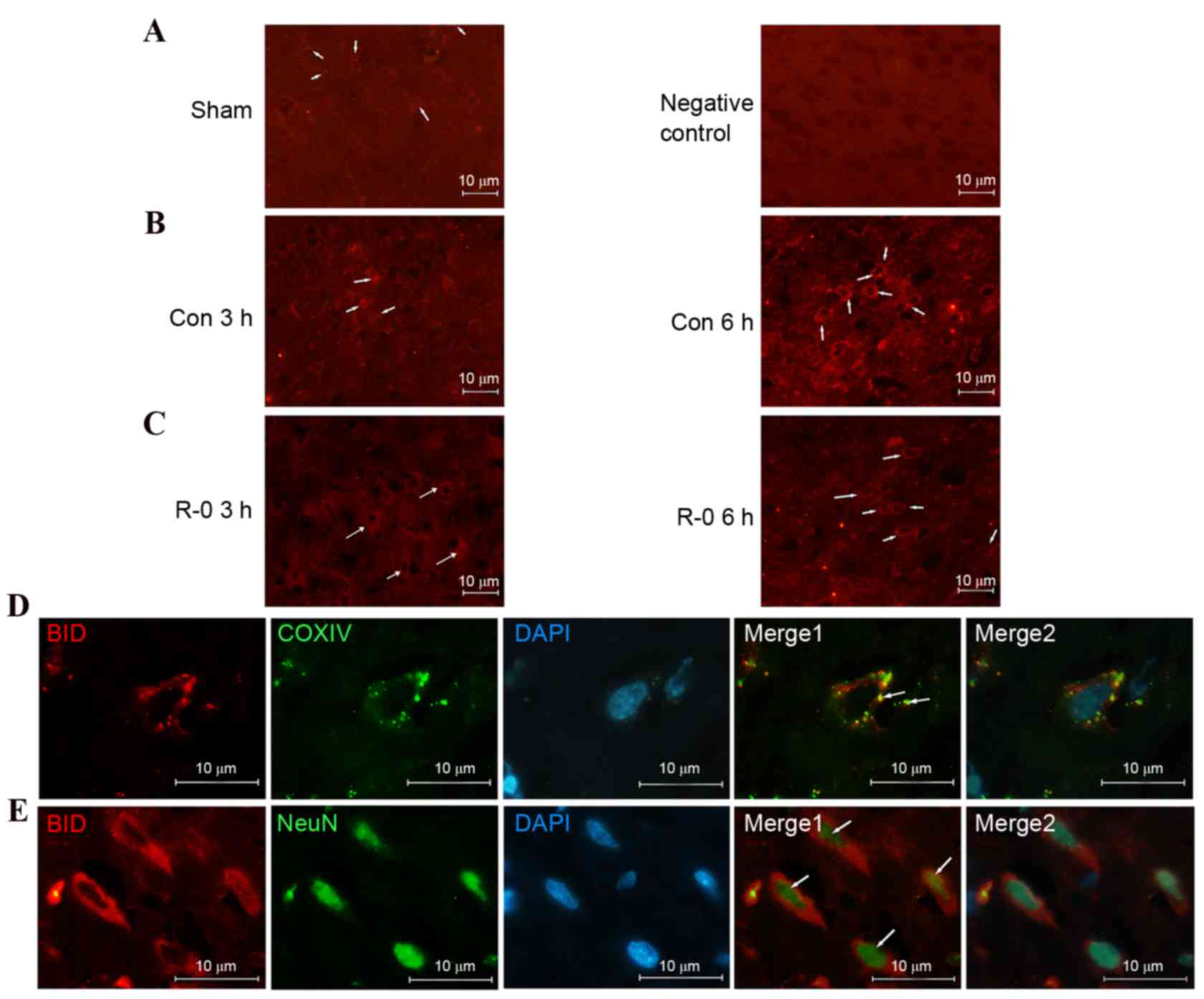Remote ischemic postconditioning confers neuroprotective effects via inhibition of the BID-mediated mitochondrial apoptotic pathway
- Authors:
- Published online on: May 30, 2017 https://doi.org/10.3892/mmr.2017.6652
- Pages: 515-522
-
Copyright: © Gao et al. This is an open access article distributed under the terms of Creative Commons Attribution License.
Abstract
Introduction
Thrombolytic therapy following the onset of stroke has been demonstrated to prevent apoptosis of neural cells at risk of injury; however, the re-establishment of blood circulation may contribute to delayed secondary brain damage (1). Our previous study demonstrated that reperfusion induced mitochondrial ultrastructural alterations and dysfunction (2); mitochondria are important in the regulation of intrinsic apoptosis (3). Previous in vivo and in vitro models have demonstrated that postconditioning significantly inhibits neuronal apoptosis and protects the brain from reperfusion injury (4,5). Therefore, it appears that inhibition of neuronal apoptosis is important in postconditioning-initiated neuroprotection. However, the mechanisms by which remote ischemic postconditioning (RIPostC) protects neurons from reperfusion injury and the optimal application time of RIPostC remain to be elucidated, in order for this method to be translated into clinical practice.
The B-cell lymphoma 2 (Bcl-2) family of genes regulates apoptosis and consists of two groups: Proapoptotic and anti-apoptotic proteins. The ratio between proapoptotic and anti-apoptotic members of the Bcl-2 family determines the fate of the cell (6). Bcl-2 homology 3 (BH3) interacting-domain death agonist (BID) is a member of the BH3-only subfamily, which is associated with proapoptotic proteins. It has previously been demonstrated that BID may bridge the crosstalk between extrinsic and intrinsic apoptotic pathways via its cleavage by caspase-8 (7). When cleaved, truncated BID (tBID) promotes apoptosis by activating Bcl-2-associated X protein (Bax) and eliciting mitochondrial outer membrane permeabilization (8). The infarct sizes and apoptotic indexes in bid−/− brains are greatly reduced under reperfusion conditions (9). BID is important in reperfusion-induced neuronal apoptosis, and postconditioning may significantly inhibit the apoptosis induced by ischemia/reperfusion injury. Furthermore, RIPostC may share common mechanistic signaling pathways with conventional postconditioning methods, although these are performed in ischemic organs and not in distal limbs (10). Therefore, the present study hypothesized that the BID-mediated mitochondrial apoptotic pathway is an important target for RIPostC to prevent reperfusion-induced neuronal apoptosis.
Materials and methods
Animal and experimental groups
All animal protocols used in the present study were approved by the Harbin Medical University Committee on the Guidelines for Animal Experiments (Harbin, China). All rats were handled according to the Guidelines for the Care and Use of Laboratory Animals of the National Institutes of Health. Adult male Sprague-Dawley rats (129 total; weight, 260–280 g; age, 6–8 weeks) were provided by the laboratories of The Second Affiliated Hospital of Harbin Medical University (Harbin, China), and housed under controlled conditions (temperature, 27±2°C; humidity, 60–70%) under a 12-h light/dark cycle. The rats were allowed ad libitum access to food and water. Animals were randomly divided into five groups (sham, 5 rats; control, 49 rats; R-0, 49 rats; R-10, 13 rats; R-30, 13 rats), according to the RIpostC starting times: The sham group, the control group (ischemia, 120 min), and three RIPostC groups. In the three RIPostC groups, RIPostC was conducted as follows: Three 10-min cycles of bilateral femoral artery occlusion with an interval of 10 min reperfusion after 0, 10 or 30 min of brain reperfusion (R-0, R-10 and R-30 groups, respectively), following administration of local anesthesia. The protocol for RIPostC in each group is schematically presented in Fig. 1A. In order to exclude the effect of RIPostC on the expression of apoptosis-related proteins in non-ischemic reperfusion period, a RIPostC + sham group was added as an additional control in the western blot analysis.
Transient middle cerebral artery occlusion (MCAO) model
Focal cerebral ischemia was induced by MCAO as previously described, with minor modifications (11). Briefly, 260–280 g male Sprague-Dawley rats were anesthetized by intraperitoneal injection of pentobarbital sodium (50 mg/kg in normal saline), and a caudal ventral artery catheter was inserted for continuous arterial blood pressure monitoring. Subsequently, the left external carotid artery (ECA), internal carotid artery (ICA) and common carotid artery were exposed. A 4–0 monofilament nylon thread (40–3734 PK 10; Doccol Corporation, Sharon, MA, USA) with a silicon-rubber-coated tip was then inserted into the ICA from a hole in the ECA; the suture was advanced 16–18 mm through the ICA, until a mild resistance was felt for 120 min. Blood flow was restored by gently withdrawing the suture. During these procedures, the rectal temperature was monitored continuously with a rectal probe; temperature was maintained at 37±0.5°C by the use of a lamp and pad. The mean arterial pressure and arterial blood gas values were recorded at 3 min prior to insertion of the suture (baseline), 60 min following MCAO (ischemia), and 10 min following reperfusion in each group. Rats in the sham group underwent the same procedure, with the exception of occlusion. Rats in the control group underwent ischemia/reperfusion without RIPostC. Prior to the induction of RIPostC, rats were allowed to regain consciousness, and the neurological deficit score was determined by a blinded observer based on Longa grade point standards (12). These standards were as follows: 0, no neurological deficits; 1, failure to fully extend the right forepaw; 2, circling to the right; 3, falling to the right; and 4, unable to walk spontaneously and exhibiting depressed levels of consciousness. In this experiment, the rats that scored 2 or 3 were adopted for further study.
Measurement of neurobehavioral scores and infarct volume
At 24 h after reperfusion, a revision of the 18-point scoring table proposed by Garcia et al (13) was used for neurobehavioral evaluation by a blinded observer. The 18-point scoring table was based on the following six tests: i) Spontaneous activity; ii) symmetry in the movement of four limbs; iii) forepaw outstretching; iv) climbing; v) body proprioception; and vi) response to vibrissal stimulation. The scores were summed up at the end of the evaluation (minimum score, 3; maximum score, 18). Following anesthesia with pentobarbital sodium (30 mg/kg), the mice were rapidly decapitated. The brains were frozen at −20°C for 15 min and were then cut into five 2 mm-thick coronal sections, which were stained with 2% 5-triphenyl-2H tetrazolium chloride (Sigma-Aldrich; Merck KGaA Millipore, Darmstadt Germany) at 37°C for 15 min (14). The infarct volume was analyzed using Image-Pro Plus software version 5.1 (Media Cybernetics Inc., Rockville, MD, USA). The volume of the infarct area was calculated as the percentage of the infarct volume relative to whole brain volume (15).
Terminal deoxynucleotidyl transferase dUTP nick end labeling (TUNEL) staining
Following 24 h of reperfusion, brain cell apoptosis in the peri-infarct cortex (n=5/group) was assessed in situ via TUNEL staining, as previously described (16). The infarct core and peri-infarct zone were defined according to well-established protocols in rodent models of unilateral proximal MCAO (17) (Fig 1B). TUNEL staining was quantitatively evaluated using the method described by Wang et al (18). Positively stained cells were counted in 10 random peri-infarct cortexes per rat, and the total number of positively stained cells in these pixels was then counted and expressed as cells/mm2.
Western blot analysis
At 3, 6, 12 and 24 h following reperfusion, the brain samples were collected, and protein isolation from cortical tissues, based on total cell extracts or subcellular fractionation (cytosolic), was performed as previously described (19). A total of 20 mg tissue was homogenized and lyzed in radioimmunoprecipitation assay buffer on ice and the protein concentration of samples was determined using the Bradford protein assay kit (both from Beyotime Institute of Biotechnology, Shanghai, China). Western blotting was performed as previously described (20), and the following primary antibodies were incubated at 4°C overnight: anti-BID (1:200; cat. no. sc-6358; Santa Cruz Biotechnology, Inc., Dallas, TX, USA), anti-cytochrome c (1:300; cat. no. ab13575) and anti-β-actin (1:2,000; cat. no. ab8226) (both from Abcam, Cambridge, UK). The polyvinylidene fluoride membranes were incubated with horseradish peroxidase-conjugated rabbit anti-goat immunoglobulin (Ig) G (1:1,000; cat. no. ZB-2306) and goat anti-mouse IgG secondary antibodies (1:1,000; cat. no. ZB-2305) (both from ZSGB-BIO, Beijing, China) for 1 h at room temperature. The expression of β-actin in the same membrane served as an internal reference. Blots were detected using a luminescent image analyzer and semi-quantified using Image Quant TL version 7.0 (both from GE Healthcare Biosciences, Pittsburgh, PA, USA).
Immunofluorescence analysis
Coronal sections were used for immunofluorescence staining. The procedures for immunofluorescent staining were conducted as previously described (11). Briefly, the sections were first blocked with 5% bovine serum albumin (BSA; Beyotime Institute of Biotechnology) for 30 min followed by overnight incubation at 4°C with the primary antibody, anti-BID (1:100; cat. no. sc-6358; Santa Cruz Biotechnology, Inc.), diluted in BSA. After washing three times with PBS, sections were incubated with a secondary antibody (1:300; cat. no. bs-0294M-RBITC; BIOSS, Beijing, China) conjugated to a fluorochrome at room temperature for 1 h. Following the final wash, the sections were placed on coverslips using a fluorescent mounting medium (Beyotime Institute of Biotechnology). Double immunofluorescent staining was conducted in a linear fashion as previously described (21). Following staining with the first set of primary and secondary antibodies as aforementioned, the second set of primary antibodies used were as follows: anti-cytochrome c oxidase (COX)IV (1:200; cat. no. ab153709) and anti-neuronal nuclear antigen (NeuN; 1:500; cat. no. ab177487) (both from Abcam) and corresponding secondary antibodies (1:400; cat. no. bs-0295d-FITC; BIOSS) conjugated to a different fluorochrome, were applied in the same manner as previously described. This procedure was conducted with caution, to prevent cross-reaction of the secondary antibodies with the two sets of primary antibodies, which were prepared in various species. DAPI was used as a nuclear counterstain. Images were obtained by fluorescence microscopy (Nikon Corporation, Tokyo, Japan) and microscopic examination was conducted at excitation wavelengths of 540 nm, and emission wavelengths of 605 nm (for red fluorochrome) and 465/515 nm (for green fluorochrome).
Statistical analysis
Statistical analyses were conducted using SPSS software, version 21.0 for Windows (IBM SPSS, Armonk, NY, USA). Data are presented as the mean ± standard deviation of 3 independent experiments. One-way analysis of variance was conducted to determine significance followed by Bonferroni's post hoc correction for multiple comparisons. P<0.05 was considered to indicate a statistically significant difference.
Results
RIPostC mediates neuroprotective effects
Infarct volume and neuroethology scoreThe present study did not detect any significant differences among the various time points for any of the physiological parameters, including rectal temperature, mean arterial pressure and arterial blood gas tension (Table I). It was demonstrated that RIPostC applied at the moment of reperfusion significantly reduced infarct volume in MCAO rats. All RIPostC groups, with the exception of the R-30 group (33.80±4.22%), exhibited significantly reduced infarct volumes at 24 h following reperfusion (control, 35.3±5.13%; R-0, 18.24±3.01%; R-10, 24.25±3.62%; P<0.05; Fig. 2A and B), this effect was particularly evident in the R-0 group. In addition, a similar result was observed with regards to neuroethology score; the 18-point scores of rats in the R-0 and R-10 groups were significantly higher compared with in the control group. Furthermore, the R-0 group exhibited significantly higher neurological scores compared with the R-10 group (control, 9.67±0.81; R-0, 14.66±0.62; R-10, 12.83±0.68; R-30, 9.83±0.72; P<0.05; Fig. 2C).
TUNEL-positive cellsThe present study aimed to determine whether RIPostC is associated with a decrease in neuronal apoptosis in the peri-infarct cortex. TUNEL staining was nearly negative in the sham group; however, a large number of TUNEL-positive cells was observed in the control and R-30 groups. Only a few TUNEL-positive cells were observed in other RIPostC groups, in particular, very few TUNEL-positive cells were detected in the R-0 group (Fig. 3).
These results indicated that following application of RIPostC at the early stage of reperfusion infarct volume decreased, neuroethology score improved and the rate of apoptosis was reduced; these effects were particularly evident in the R-0 group.
RIPostC-mediated effects on tBID and cytochrome c levels
Expression of tBID and cytochrome cThe R-0 group was selected to explore the potential mechanism underlying the effects of RIPostC. Western blot analysis revealed that tBID was readily detected in the control group brains 3 h following reperfusion, peaked at 6 h and was continuously detectable through the first 12 h. The R-0 group exhibited a similar trend, however tBID expression was significantly reduced at each time point compared with in the control group (Fig. 4A and B). Cytochrome c release into the cytosolic fraction was detected in the R-0 and control groups 3 h following reperfusion and at various time points throughout the first 24 h. However, its expression was markedly reduced in the R-0 group compared with in the control group (Fig. 4C and D). In the RIPostC + sham group, the expression levels of tBID and cytochrome c were similar to those in the sham group. The peak expression of tBID and cytochrome c was significantly decreased in the R-0 group compared with control group (Fig. 5).
tBID level and translocationThe immunofluorescence signals of BID were very low in the non-ischemic cortex and indicated a diffusive pattern, consistent with its cytosolic distribution in normal cells. However, the signal increased following reperfusion, particularly 6 h after reperfusion, suggesting mitochondrial localization. Conversely, expression was weaker in the R-0 group compared with in the control group. Subcellular localization in the mitochodria was further confirmed by double-label staining with the anti-COXIV antibody. Furthermore, tBID was activated in the neurons as demonstrated by double-label staining with anti-NeuN antibody (a neuronal marker) (Fig. 6).
Discussion
Reperfusion following ischemia is often associated with induction of apoptosis-like cell death (15). The release of intramitochondrial contents into the cytosol is considered irreversible during the induction of apoptotic signaling (22). The present study demonstrated that RIPostC, applied as early as possible following reperfusion, may result in a significant neuroprotective effect in the rat MCAO model. The protective mechanisms of RIPostC may be associated with inhibition of the BID-mediated mitochondrial apoptotic pathway.
Hess et al (23) reported that preclinical reports of remote limb conditioning in focal cerebral ischemia are promising; however, the underlying mechanism remains to be elucidated. At present, it is known that numerous mechanisms are involved: i) Humoral factors acting via systemic circulation; ii) neurogenic transmission with involvement of the autonomic nervous system; and iii) effects on circulating immune cells (24). However, a previous study involving the heart suggested that the pathway of protection in the target organ involves activation of kinases to resolve the reperfusion injury, or activation of survival factor enhancement pathways, which ultimately converge on the mitochondria to prevent opening of the mitochondrial permeability transition pore (25). The present study demonstrated that infarct volume, and the number of apoptotic cells, was significantly attenuated following administration of RIPostC; therefore, further investigations were conducted regarding the effects of RIPostC on the BID-mediated mitochondrial apoptotic pathway. The results appeared to be consistent with a previous study by Darling et al, which indicated that three cycles of occlusion-reperfusion in the first minute are optimal, and delaying postconditioning for even 1 min eliminates protection in the heart (26). The differing degree of protection between the results of the present study and other reports may reside in the differences in the duration of the ischemic insults and animal models. The results of the present study indicated that humoral factors may have a temporal profile of decay that reduces effectiveness, proportionate to the interval between ischemic stimulus and reperfusion, confirming that timing of the initiation of postconditioning is critical in the brain and heart.
As a BH3 domain-containing proapoptotic Bcl-2 family member, BID is inactive in the cytosol until exposed to various stress stimuli. tBID has been demonstrated to be important for the efficient recruitment of cytosolic Bax to the mitochondrial outer membrane (27), resulting in alterations to mitochondrial membrane permeability (7). In the present study, a western blot analysis detected tBID and cytochrome c expression at the early stages of reperfusion. Translocation from the cytosol to mitochondria is considered an important activating mechanism for tBID and the propagation of extracellular to intracellular apoptotic signals (8), and this is consistent with the immunofluorescence results obtained. BID was activated and translocated to ischemic neuronal mitochondria following reperfusion. Numerous proapoptotic members of the Bcl-2 family may induce cytochrome c release; however, tBID may initiate release of almost all mitochondrial cytochrome c into the cytosol at a very low concentration compared with others (28). This may provide an explanation as to why its expression peak appears later than that of cytochrome c. These data suggested that BID is critical to the early activation of the mitochondrial apoptotic pathway.
Notably, BID activation and cytochrome c release were not observed at the end of MCAO (data not shown). This is consistent with the previous findings, which suggested that induction of apoptosis is a delayed event (29). This delay may be attributable to the restoration of cellular energy levels during the reperfusion phase, which may be essential for the energy-requiring steps in the execution of the apoptotic program (30); similarly, proapoptotic substances produced during reperfusion may have contributed to the delay. Notably, in response to RIPostC, neither the inhibition of cytochrome c release nor the neuroprotection against MCAO was complete, suggesting that the mitochondrial apoptotic pathway may have been activated by numerous mechanisms, or other factors were present resulting in reperfusion injury. However, BID bridges the activation of extrinsic and intrinsic apoptotic pathways in the early stage, due to its strategic position in the apoptotic signaling pathway, and may therefore be considered an ideal target for therapeutic intervention.
The present study used the bilateral femoral artery, as it is more practical to induce limb ischemia by placing a tourniquet on an extremity for a brief period. Therefore, RIPostC may have translational potential as a routine procedure in emergencies and in prehospital settings, and as a thrombolytic treatment in acute brain ischemia. However, the long-term effects of RIPostC were not observed, and it remains to be elucidated if underlying comorbidities may affect the efficacy of RIPostC; therefore, further studies are required.
In conclusion, the protective effects of RIPostC may be due to inhibition of the BID-mediated mitochondrial apoptotic pathway. The results of the present study suggested that RIPostC applied at the moment of reperfusion may exert a potent neuroprotective effect against focal cerebral ischemia/reperfusion injury. These data may help to elucidate the complex signaling cascades involved in the neuroprotective effects of RIPostC, leading to its potential future use as an effective treatment for stroke patients.
Acknowledgements
The present study was supported by the National Natural Science Foundation of China (grant no. 81271456).
References
|
Schaller B and Graf R: Cerebral ischemia and reperfusion: The pathophysiologic concept as a basis for clinical therapy. J Cereb Blood Flow Metab. 24:351–371. 2004. View Article : Google Scholar : PubMed/NCBI | |
|
Li J, Yu W, Li XT, Qi SH and Li B: The effects of propofol on mitochondrial dysfunction following focal cerebral ischemia-reperfusion in rats. Neuropharmacology. 77:358–368. 2014. View Article : Google Scholar : PubMed/NCBI | |
|
Li J, Han B, Ma X and Qi S: The effects of propofol on hippocampal caspase-3 and Bcl-2 expression following forebrain ischemia-reperfusion in rats. Brain Res. 1356:11–23. 2010. View Article : Google Scholar : PubMed/NCBI | |
|
Prasad SS, Russell M and Nowakowska M: Neuroprotection induced in vitro by ischemic preconditioning and postconditioning: Modulation of apoptosis and PI3K-Akt pathways. J Mol Neurosci. 43:428–442. 2011. View Article : Google Scholar : PubMed/NCBI | |
|
Zhang W, Wang B, Zhou S and Qiu Y: The effect of ischemic post-conditioning on hippocampal cell apoptosis following global brain ischemia in rats. J Clin Neurosci. 19:570–573. 2012. View Article : Google Scholar : PubMed/NCBI | |
|
Meller R, Cameron JA, Torrey DJ, Clayton CE, Ordonez AN, Henshall DC, Minami M, Schindler CK, Saugstad JA and Simon RP: Rapid degradation of Bim by the ubiquitin-proteasome pathway mediates short-term ischemic tolerance in cultured neurons. J Biol Chem. 281:7429–7436. 2006. View Article : Google Scholar : PubMed/NCBI | |
|
Wang Y and Tjandra N: Structural insights of tBid, the caspase-8-activated Bid, and its BH3 domain. J Biol Chem. 288:35840–35851. 2013. View Article : Google Scholar : PubMed/NCBI | |
|
Shamas-Din A, Bindner S, Zhu W, Zaltsman Y, Campbell C, Gross A, Leber B, Andrews DW and Fradin C: tBid undergoes multiple conformational changes at the membrane required for Bax activation. J Biol Chem. 288:22111–22127. 2013. View Article : Google Scholar : PubMed/NCBI | |
|
Tobaben S, Grohm J, Seiler A, Conrad M, Plesnila N and Culmsee C: Bid-mediated mitochondrial damage is a key mechanism in glutamate-induced oxidative stress and AIF-dependent cell death in immortalized HT-22 hippocampal neurons. Cell Death Differ. 18:282–292. 2011. View Article : Google Scholar : PubMed/NCBI | |
|
Ding ZM, Wu B, Zhang WQ, Lu XJ, Lin YC, Geng YJ and Miao YF: Neuroprotective effects of ischemic preconditioning and postconditioning on global brain ischemia in rats through the same effect on inhibition of apoptosis. Int J Mol Sci. 13:6089–6101. 2012. View Article : Google Scholar : PubMed/NCBI | |
|
Yan C, Chen J, Chen D, Minami M, Pei W, Yin XM and Simon RP: Overexpression of the cell death suppressor Bcl-w in ischemic brain: Implications for a neuroprotective role via the mitochondrial pathway. J Cereb Blood Flow Metab. 20:620–630. 2000. View Article : Google Scholar : PubMed/NCBI | |
|
Longa EZ, Weinstein PR, Carlson S and Cummins R: Reversible middle cerebral artery occlusion without craniectomy in rats. Stroke. 20:84–91. 1989. View Article : Google Scholar : PubMed/NCBI | |
|
Garcia JH, Wagner S, Liu KF and Hu XJ: Neurological deficit and extent of neuronal necrosis attributable to middle cerebral artery occlusion in rats. Statistical validation. Stroke. 26:627–635. 1995. View Article : Google Scholar : PubMed/NCBI | |
|
Gao L, Ji X, Song J, Liu P, Yan F, Gong W, Dang S and Luo Y: Puerarin protects against ischemic brain injury in a rat model of transient focal ischemia. Neurol Res. 31:402–406. 2009. View Article : Google Scholar : PubMed/NCBI | |
|
Li X, Luo P, Wang F, Yang Q, Li Y, Zhao M, Wang S, Wang Q and Xiong L: Inhibition of N-myc downstream-regulated gene-2 is involved in an astrocyte-specific neuroprotection induced by sevoflurane preconditioning. Anesthesiology. 121:549–562. 2014. View Article : Google Scholar : PubMed/NCBI | |
|
Wang Q, Peng Y, Chen S, Gou X, Hu B, Du J, Lu Y and Xiong L: Pretreatment with electroacupuncture induces rapid tolerance to focal cerebral ischemia through regulation of endocannabinoid system. Stroke. 40:2157–2164. 2009. View Article : Google Scholar : PubMed/NCBI | |
|
Wang KC, Koprivica V, Kim JA, Sivasankaran R, Guo Y, Neve RL and He Z: Oligodendrocyte-myelin glycoprotein is a Nogo receptor ligand that inhibits neurite outgrowth. Nature. 417:941–944. 2002. View Article : Google Scholar : PubMed/NCBI | |
|
Wang Q, Zhang X, Ding Q, Hu B, Xie Y, Li X, Yang Q and Xiong L: Limb remote postconditioning alleviates cerebral reperfusion injury through reactive oxygen species-mediated inhibition of delta protein kinase C in rats. Anesth Analg. 113:1180–1187. 2011. View Article : Google Scholar : PubMed/NCBI | |
|
Gidday JM: Cerebral preconditioning and ischaemic tolerance. Nat Rev Neurosci. 7:437–448. 2006. View Article : Google Scholar : PubMed/NCBI | |
|
Zhou Y, Lekic T, Fathali N, Ostrowski RP, Martin RD, Tang J and Zhang JH: Isoflurane posttreatment reduces neonatal hypoxic-ischemic brain injury in rats by the sphingosine-1-phosphate/phosphatidylinositol-3-kinase/Akt pathway. Stroke. 41:1521–1527. 2010. View Article : Google Scholar : PubMed/NCBI | |
|
Dirnagl U, Simon RP and Hallenbeck JM: Ischemic tolerance and endogenous neuroprotection. Trends Neurosci. 26:248–254. 2003. View Article : Google Scholar : PubMed/NCBI | |
|
Peixoto PM, Teijido O, Mirzalieva O, Dejean LM, Pavlov EV, Antonsson B and Kinnally KW: MAC inhibitors antagonize the pro-apoptotic effects of tBid and disassemble Bax/Bak oligomers. J Bioenerg Biomembr. 49:65–74. 2017. View Article : Google Scholar : PubMed/NCBI | |
|
Hess DC, Hoda MN and Bhatia K: Remote limb perconditioning [corrected] and postconditioning: Will it translate into a promising treatment for acute stroke? Stroke. 44:1191–1197. 2013. View Article : Google Scholar : PubMed/NCBI | |
|
Weber C: Far from the heart: Receptor cross-talk in remote conditioning. Nat Med. 16:760–762. 2010. View Article : Google Scholar : PubMed/NCBI | |
|
Szijártó A, Czigány Z, Turóczi Z and Harsányi L: Remote ischemic perconditioning-a simple, low-risk method to decrease ischemic reperfusion injury: Models, protocols and mechanistic background. A review. J Surg Res. 178:797–806. 2012. View Article : Google Scholar : PubMed/NCBI | |
|
Darling CE, Jiang R, Maynard M, Whittaker P, Vinten-Johansen J and Przyklenk K: Postconditioning via stuttering reperfusion limits myocardial infarct size in rabbit hearts: Role of ERK1/2. Am J Physiol Heart Circ Physiol. 289:H1618–H1626. 2005. View Article : Google Scholar : PubMed/NCBI | |
|
Ott M, Norberg E, Zhivotovsky B and Orrenius S: Mitochondrial targeting of tBid/Bax: A role for the TOM complex? Cell Death Differ. 16:1075–1082. 2009. View Article : Google Scholar : PubMed/NCBI | |
|
Luo X, Budihardjo I, Zou H, Slaughter C and Wang X: Bid, a Bcl2 interacting protein, mediates cytochrome c release from mitochondria in response to activation of cell surface death receptors. Cell. 94:481–490. 1998. View Article : Google Scholar : PubMed/NCBI | |
|
Lipton P: Ischemic cell death in brain neurons. Physiol Rev. 79:1431–1568. 1999.PubMed/NCBI | |
|
Leist M, Single B, Castoldi AF, Kühnle S and Nicotera P: Intracellular adenosine triphosphate (ATP) concentration: A switch in the decision between apoptosis and necrosis. J Exp Med. 185:1481–1486. 1997. View Article : Google Scholar : PubMed/NCBI |



